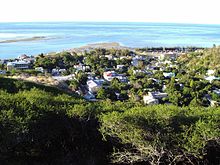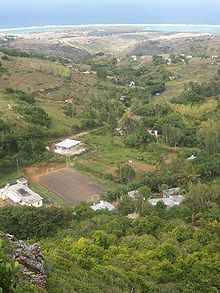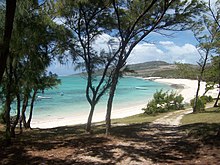Rodrigues (island)
| Rodrigues | |
|---|---|
| Rodrigues topographic road map | |
| Waters | Indian Ocean |
| Archipelago | Mascarens |
| Geographical location | 19 ° 43 ′ S , 63 ° 25 ′ E |
| length | 19 km |
| width | 9 km |
| surface | 109 km² |
| Highest elevation |
Mont Limon 398 m |
| Residents | 41,669 (2014) 382 inhabitants / km² |
| main place | Port Mathurin |
| Flag of Rodrigues | |
Rodrigues (also Rodriguez ) is a Mauritius island in the Indian Ocean , 580 km east of the main island of Mauritius. The capital of the 109 km² island is Port Mathurin , the main language is French , the colloquial language is Rodriguais , a French Creole . The island is part of the island chain of the Mascarene surrounded in turn by several small islands. The island has over 40,000 inhabitants who, apart from small European and Tamil minorities, are of African descent.
geography
The island is of volcanic origin and surrounded on all sides by an extensive lagoon . The coral reef that borders the lagoon is at different distances from the coast and offers only a few narrow passages for shipping. The highest point on the island, the Mont Limon, has a height of 398 meters. The climate is rougher than in Mauritius, the summers hotter (29 to 33 ° C), the winters cooler (14 to 18 ° C), the cyclone season even more violent. It's also far drier than the main island, with long periods of no rainfall. The small offshore islands Île aux Cocos and Île aux Sables are under nature protection.
population
As in Mauritius, despite over 150 years of British rule, the population has remained French to this day due to the descent of the ruling upper class. After the abolition of slavery, tens of thousands of Indian contract workers were brought into the country on the main island of Mauritius in order to provide enough workers for the monoculture cultivation of sugar cane. Today the population of Indian origin makes up the clear majority of the population of Mauritius. Sugar cane cultivation never played a major role on Rodrigues, so the Creoles are the vast majority here. Indian and Chinese families did not immigrate until the 1890s and soon played an important role in trade.
The population is 96% Catholic, 3% Anglican and 1% are roughly equal parts Muslim, Hindu or Buddhist.
structure
Rodrigues, there are 14 zones (statistical districts), further in 182 localities ( localities are divided):
| No. | Zone | Population Census 2000 |
|---|---|---|
| 1 | Piments-Baie Topaze | 1445 |
| 2 | La Ferme | 1112 |
| 3 | Baie Malgache | 1076 |
| 4th | Oyster Bay | 2594 |
| 5 | Port Mathurin | 5929 |
| 6th | Grand Baie-Montagne Goyaves | 844 |
| 7th | Roche Bon Dieu-Trèfles | 2059 |
| 8th | Lataniers-Mont Lubin | 3806 |
| 9 | Petit Gabriel | 3658 |
| 10 | Mangues-Quatre Vents | 2870 |
| 11 | Plaine Corail-La Fouche Corail | 2832 |
| 12 | Rivière Cocos | 2893 |
| 13 | Port Sud-Est | 2717 |
| 14th | Coromandel engraving | 1944 |
| Rodrigues | 35779 |
history
The uninhabited Mascarenes were already known to the Arabs , who called Rodrigues Dina a Robi . The island was finally named after Diogo Rodrigues , a helmsman of a small Portuguese fleet sailing under the command of Pedro Mascarenha in 1538 , which passed the archipelago on the way to Goa .
In 1601 the Dutch landed on the island on their way east. A settlement attempt under Admiral Wolphart Harman failed, as did that under Gerrit Andriez after a few weeks. In contrast to Mauritius, Rodrigues was never officially taken over by the Netherlands. For a long time the island was only a landmark for passing ships, turning north towards India and a place of refuge from storms or a supply of fresh water and turtle meat .
In 1691 a group of Huguenots who had fled France tried to establish a Protestant republic called Eden on Rodrigues. Because of fighting with the Dutch, however, only eight men, led by François Leguat , reached the Bay of Mathurin. For the first time, the island had residents who could also eat well on the fertile island. After two years, however, due to the lack of women, they gave up and crossed over to Mauritius with a self-made launch , where they were arrested by the Dutch as suspected of espionage. The men were abandoned on a small offshore island, but, experienced as they were, died not as expected. They were then brought to Batavia and after a trial deported to France. In 1708 Leguat published a description of his seven-year journey with natural history observations under the title Voyages et aventures de François Leguat et de ses compagnons en deux isles désertes des Indes orientales .
These stories inspired the French to make another attempt at colonization in 1725. The colonists caught thousands of giant turtles and sold them to passing ships as travel provisions. In 1735 the first permanent settlement of Port Mathurin was established. Later, the island was also home to a kind of French prison colony. A group of Malagasy people also came to the island voluntarily and introduced rice cultivation here .
In 1761 the French Académie des Sciences selected the island as an observation point for the passage of Venus through the sun. The mathematician and astronomer Alexandre Guy Pingré therefore spent four months on the island. In the same year there was an attack by the British as part of the Seven Years' War . The French ships encountered in the port were destroyed, leaving around 70 French residents of the island without any means of contact.
The remote island on the fringes was also involved in the next major Anglo-French conflict, the wars in the wake of the French Revolution . In order to block the strategically important Mauritius at sea, Rodrigues was used by the British as a base. On December 27, 1808, the island was militarily occupied and officially occupied by a fleet of 21 ships with a crew of 16,000. The French even considered building a leper colony as a deterrent . To supply this force, thousands of giant tortoises were slaughtered and entire ebony forests were cleared. On October 29, 1810, the island was used by a 10,000-strong British force as the starting point for an invasion of the islands of Réunion and Mauritius. With the Treaty of Paris in 1814 , Réunion returned to France, Rodrigues remained with Mauritius in Great Britain . A census in 1804 showed a population of 22 Europeans and 82 slaves who had come from Madagascar and Mozambique . The slaves were not released until 1839. As a result, the African population mostly earned their living by raising cattle, goats and pigs in areas that belonged to the Crown.
Rodrigues was spared from the great malaria and cholera epidemics that claimed tens of thousands of victims in Mauritius from 1866 to 1868 and the 1890s, as it did not have such close ties with India.
At the beginning of the 20th century, life on Rodrigues was pleasant, the island could easily feed the then small population of 3,000 people, meat and fish were cheap, the crisis in the sugar cane industry in Mauritius, which lost a large part of its population due to emigration, affected the Side island not. The island had become the warehouse of Mauritius , and livestock, fishing and vegetable growing flourished. In 1930 there were already 8,000 inhabitants. The Second World War only affected Rodrigues indirectly. The stationing of a small military unit for the telegraph cable installed since 1901 through the Indian Ocean to Australia gave the colony a small economic boom.
In the 1970s there was only one paved road in Port Mathurin and around 60 cars, mostly owned by administrators.
Since the predominantly Catholic population did not identify with Mauritius, which they considered to be ruled by Hindus , enthusiasm for Mauritius' independence in 1968 was low. The Indo-Mauritian officials were perceived as colonialists on the Creole Island . The wish to remain under the rule of the United Kingdom was refused in London . Rodrigues has enjoyed autonomy with its own regional assembly within the state of Mauritius since 2002.
economy
In the past, the island was covered by dense rainforests that were almost completely cut down. Erosion and water shortages are the result, which is why reforestation began in the 1980s. Rodrigues is now severely overpopulated and suffers from severe, probably irreversible ecological damage and from acute water shortages. The export of meat to Mauritius was until recently the most important source of income for the economy. Other important export goods were (salted) fish and tobacco. Another economic mainstay of the people on Rodrigues is the fishing and trading of squid .
Rodrigues is the only Creole island in the Indian Ocean that never developed a large-scale plantation economy . The government still owns 90% of the land, which is repeatedly leased to the farmers for ten-year contracts; the second largest landowner is the Catholic Church .
After cyclones decimated the fertile land, many farmers who raised cattle were ruined. As a result, the export of these animals fell sharply. To counteract this, the government in Port Louis , which Rodrigues had neglected for a long time, abolished import duties and even subsidized necessary imports, promoted business start-ups and expanded green tourism . However, the small amount of tourism is by far not enough to secure a livelihood for the rapidly growing population. The result is uncontrolled emigration to Mauritius, where the Creoles from Rodrigues live in miserable circumstances. Notable investments have only been flowing into Rodrigues since the mid-1990s.
tourism
Tourism as another economic mainstay of the island is developing only slowly. In 2006 there were only 15 hotels and pensions, in addition to a few private accommodations. The number of beds is to be increased to 800. The newly created airport is served daily by propeller planes from Mauritius, the ferry from the main island only docks three times a month in Port Mathurin and a total of three taxis are enough to transport the guests.
Climate table
| Rodrigues | ||||||||||||||||||||||||||||||||||||||||||||||||
|---|---|---|---|---|---|---|---|---|---|---|---|---|---|---|---|---|---|---|---|---|---|---|---|---|---|---|---|---|---|---|---|---|---|---|---|---|---|---|---|---|---|---|---|---|---|---|---|---|
| Climate diagram | ||||||||||||||||||||||||||||||||||||||||||||||||
| ||||||||||||||||||||||||||||||||||||||||||||||||
|
Average monthly temperatures and rainfall for Rodrigues
Source: wetterkontor.de
|
|||||||||||||||||||||||||||||||||||||||||||||||||||||||||||||||||||||||||||||||||||||||||||||||||||||||||||||||||||||||||||||||||||||||||||||||||||||||||||||||||||||
literature
- François Leguat: The Voyage of Franois Leguat of Bresse to Rodriguez, Mauritius, Java, and the Cape of Good Hope. Adamant Media Verlag, Boston 2001, ISBN 978-1-4021-9503-7 .
- Richard Andree: The Emigrants on the Mascarene Mountains (1690-1698) . In: Otto Spanner (Hrsg.): Real and true robinsonades, trips and travel experiences from all zones. Otto Spanner's youth and home library . Second series, eleventh volume. Verlag Otto Spanner, Leipzig 1868, p. 41-58 . Digitized
Web links
Individual evidence
- ↑ POPULATION AND VITAL STATISTICS REPUBLIC OF MAURITIUS, JANUARY - JUNE 2014 estimate (PDF)
- ↑ Harry Brind: Lying Abroad. Diplomatic Memoirs. Radcliffe Press 1999, ISBN 1-86064-377-9 , p. 146.
- ^ Wolfgang Därr: Mauritius. Proper travel. With travel atlas u. Route planner. Travel individually! DuMont, Cologne 2008, ISBN 3-7701-7610-3 , p. 272.
- ↑ a b Map of the zones ( Memento of the original dated February 6, 2010 in the Internet Archive ) Info: The archive link was inserted automatically and has not yet been checked. Please check the original and archive link according to the instructions and then remove this notice.
- ↑ a b Table D6 - Resident population by geographical location and religious group ( Memento of the original from November 17, 2010 in the Internet Archive ) Info: The archive link was inserted automatically and has not yet been checked. Please check the original and archive link according to the instructions and then remove this notice.
- ^ Auguste Toussaint: History of the Indian Ocean . University of Chicago Press 1966, p. 109.
- ^ Wolfgang Därr: Mauritius. Proper travel. With travel atlas u. Route planner. Travel individually! Verlag DuMont, Cologne 2008, ISBN 3-7701-7610-3 , p. 274.
- ^ Jan Dodd: Mauritius, Réunion and Seychelles . Lonely Planet Verlag, 2004, ISBN 978-0-86442-748-9 , p. 121.
- ^ Wolfgang Därr: Mauritius. Travel manual. Verlag DuMont, Cologne 1993, ISBN 3-7701-1446-9 , p. 63.
- ^ Wolfgang Därr: Mauritius. Proper travel. With travel atlas u. Route planner. Travel individually! Verlag DuMont, Cologne 2008, ISBN 3-7701-7610-3 , p. 274.
- ^ Wolfgang Därr: Mauritius. Proper travel. With travel atlas u. Route planner. Travel individually! DuMont, Cologne 2008, ISBN 3-7701-7610-3 , pp. 42 and 275.
- ^ Wolfgang Därr: Mauritius. Travel manual. DuMont, Cologne 1993, ISBN 3-7701-1446-9 , pp. 68-71.
- ^ Wolfgang Därr: Mauritius. Proper travel. With travel atlas u. Route planner. Travel individually! DuMont, Cologne 2008, ISBN 3-7701-7610-3 , p. 275.
- ↑ Harry Brind: Lying Abroad. Diplomatic Memoirs. Radcliffe Press, 1999, ISBN 1-86064-377-9 , p. 146.
- ↑ Shihan de Silva Jayasuriya, Richard Pankhurst: The African Diaspora in the Indian Ocean. Africa World Press, Trenton 2001, ISBN 0-86543-980-X , p. 165.
- ↑ Official government website of Mauritius ( Memento of the original from April 22, 2008 in the Internet Archive ) Info: The archive link was inserted automatically and has not yet been checked. Please check the original and archive link according to the instructions and then remove this notice.
-
^ Wolfgang Därr: Mauritius. Travel manual. DuMont, Cologne 1993, ISBN 3-7701-1446-9 , p. 102.
Shihan de Silva Jayasuriya, Richard Pankhurst: The African Diaspora in the Indian Ocean. Africa World Press, Trenton 2001, ISBN 0-86543-980-X , pp. 164f. - ↑ Shihan de Silva Jayasuriya, Richard Pankhurst: The African Diaspora in the Indian Ocean. Africa World Press, Trenton 2001, ISBN 0-86543-980-X , p. 164.
-
^ Wolfgang Därr: Mauritius. Proper travel. With travel atlas u. Route planner. Travel individually! DuMont, Cologne 2008, ISBN 3-7701-7610-3 , p. 273.
Alan Mountain, Alain Proust: This is Mauritius. Verlag Struik, 2000, ISBN 1-84330-301-9 , p. 38. - ↑ Shihan de Silva Jayasuriya, Richard Pankhurst: The African Diaspora in the Indian Ocean. Africa World Press, Trenton 2001, ISBN 0-86543-980-X , p. 165.
- ^ Wolfgang Därr: Mauritius. Proper travel. With travel atlas u. Route planner. Travel individually! DuMont, Cologne 2008, ISBN 3-7701-7610-3 , p. 272.
- ↑ Martina Miethig: Mauritius and Rodrigues. ADAC Verlag, Munich 2007, ISBN 978-3-89905-477-4 , p. 109ff.







